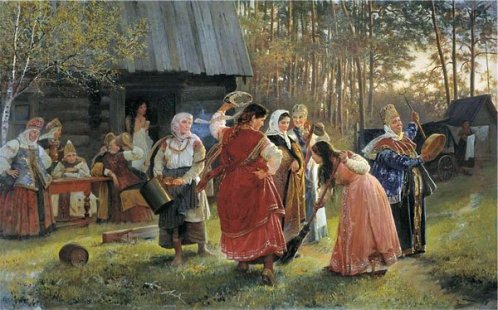7. Caracalla in the German version
It is so paradoxical that the bloody and warlike Emperor Caracalla is associated above all with baths not only in Italy, but also in Germany. But here the story is a little different. When Roman soldiers under his leadership fought with German tribes, trying to include these northern territories in the empire, they discovered some wonderful warm mineral springs. And immediately set up camping baths in the manner to which they were accustomed. Then the soldiers left - the Germanic tribes, as we know, managed to defend their freedom - but the baths remained. They are still functioning today.
Over time, a town grew up near the springs, which we know today as Baden-Baden. In the 18th and 19th centuries it was the most fashionable resort among the Russian aristocracy. This love was instilled by the German Princess Louise, who hailed from Baden-Baden, when she became the wife of the Russian Emperor Alexander the First. She went down in history as Empress Elizabeth Alexeevna.
Already in the 20th century, modern thermal complexes were built next to the historical baths. The largest of them is called "Caracalla", which is quite right - it is the largest in Europe. The baths alone occupy an area of 4 thousand square meters. meters. In the spirit of Roman traditions here you can listen to a live concert of classical music right from the pool. Only unlike the ancient Roman original, visitors have to pay quite a lot for the entrance.
It is so paradoxical that the bloody and warlike Emperor Caracalla is associated above all with baths not only in Italy, but also in Germany. But here the story is a little different. When Roman soldiers under his leadership fought with German tribes, trying to include these northern territories in the empire, they discovered some wonderful warm mineral springs. And immediately set up camping baths in the manner to which they were accustomed. Then the soldiers left - the Germanic tribes, as we know, managed to defend their freedom - but the baths remained. They are still functioning today.
Over time, a town grew up near the springs, which we know today as Baden-Baden. In the 18th and 19th centuries it was the most fashionable resort among the Russian aristocracy. This love was instilled by the German Princess Louise, who hailed from Baden-Baden, when she became the wife of the Russian Emperor Alexander the First. She went down in history as Empress Elizabeth Alexeevna.
Already in the 20th century, modern thermal complexes were built next to the historical baths. The largest of them is called "Caracalla", which is quite right - it is the largest in Europe. The baths alone occupy an area of 4 thousand square meters. meters. In the spirit of Roman traditions here you can listen to a live concert of classical music right from the pool. Only unlike the ancient Roman original, visitors have to pay quite a lot for the entrance.

8. Baths with songs - that's the Georgian way
One of the main attractions of Tbilisi has always been its healing natural springs, which made it possible to build sulfur thermal baths with natural steam. The very first baths appeared here in the times of Urartu state, in the ninth century BC. Since ancient times, ceramic pipes were laid from the springs to the city. Luxurious marble-lined pools were a must for every visitor.
National traditions have left their imprint on water procedures. It was customary for Georgians to organize feasts with feasts and guests in the baths, during which men sang beautiful long songs.
Another national peculiarity of Georgian baths is skillful masseurs, who were always ready to serve the visitors. Here is how this process was described by Alexander Pushkin, who was an assiduous visitor of these establishments:
"Gassan (that was the name of a noseless Tatar) began by laying me out on the warm stone floor; after that he began to break my cocks, pull my joints, beat me hard with his fist... I did not feel the slightest pain, but amazing relief. ...I have never met anything more luxurious than Tiflis baths in Russia or Turkey.
One of the main attractions of Tbilisi has always been its healing natural springs, which made it possible to build sulfur thermal baths with natural steam. The very first baths appeared here in the times of Urartu state, in the ninth century BC. Since ancient times, ceramic pipes were laid from the springs to the city. Luxurious marble-lined pools were a must for every visitor.
National traditions have left their imprint on water procedures. It was customary for Georgians to organize feasts with feasts and guests in the baths, during which men sang beautiful long songs.
Another national peculiarity of Georgian baths is skillful masseurs, who were always ready to serve the visitors. Here is how this process was described by Alexander Pushkin, who was an assiduous visitor of these establishments:
"Gassan (that was the name of a noseless Tatar) began by laying me out on the warm stone floor; after that he began to break my cocks, pull my joints, beat me hard with his fist... I did not feel the slightest pain, but amazing relief. ...I have never met anything more luxurious than Tiflis baths in Russia or Turkey.




















